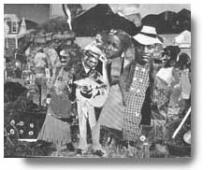Opinion: A Rare Opportunity To See Political Art

Anyone who thinks that American art of the past 40 years lacks political relevance and social commitment should by all means proceed directly to the Parrish Art Museum, where "In the Eye of the Storm: An Art of Conscience, 1930-1970" is now on display, perhaps to the puzzled amusement of conservative, well-heeled, apolitical locals.
This traveling show of 62 works from the collection of Phillip J. and Suzanne Schiller, which originated at Chicago's Terra Museum of American Art, provides an eye-opening survey of work created since 1930 to address the great civic and social issues of the past half-century: poverty, fascism, imperialist war, McCarthyism, and (particularly) American racism.
Challenges
The show proves quite forcefully that while an abstract, apolitical, and inward-looking art may be the most widely celebrated of our time, a significant number of highly talented artists have labored in the shadows to create a different sort of art, one which seeks to address social issues (usually from a leftist point of view) through the medium of visual art.
This challenging and paradoxical show (made particularly so by its current venue in one of the least liberal villages on the East End) raises a challenging question about the role of art in contemporary society:
Is art, after all, merely a luxury item, created for the amusement of the privileged upper classes, or else, alternately, a way of criticizing (and thus promoting change in) the current social order?
Apparently it is both, since the works serve not only as historical documents of past social issues but visual challenges to current art viewers - that is, if anyone not of the privileged intellectual classes is actually looking at art these days.
Limited Audience
The Schillers themselves state in their catalogue that they are wealthy and conservative, have a limited sympathy for the ideologies of the artists they collect, but collect the work anyway, and hang it in their home. In that way they probably reflect the potential audience for the show at the Parrish.
Unless the village of Southampton decides to bus in people from Flanders and Riverhead, the audience for this work may well be limited to people just like the Schillers: privileged, intellectual, libertarians who value art for its historical importance, its social cachet, and (presumably to a lesser extent) its ability to promote (in the words of Leon Trotsky) "permanent revolution."
For those who do attend the exhibit, however, the rewards are many, and surely as exciting and thought-provoking to the privileged as to the underclass.
Gwathmey's "Custodian"
Two extraordinary works by Jacob Lawrence begin the show, one describing life in a bordello, the other showing prostitutes out on the street.
A brilliant series of lithographs and woodcuts give black-and-white accounts of American racism. Robert Gwathmey takes on the same subject in a bold painting called "Custodian" (1963, oil on canvas), in which a discontented black man sits before piles of refuse and a poster of a headless man holding a watermelon.
The sky overhead is a searing yellow-ocher, a color art viewers may identify more readily with Van Gogh than the Deep South.
The artist, a Southerner, lived much of his life in Amagansett.
Strong Graphics
Others featured in the show are about as well-known as artists concerned with social issues can be - Ben Shahn, Rockwell Kent, Romare Bearden, George Grosz, and George Tooker - making this exhibit an excellent opportunity for the public to acquaint itself further with some of the best socially inspired artists of the past half-century.
Other works, by artists like Joseph Hirsch, Joseph Leboit, Peter Saul, Lucienne Bloch, and Henry Koerner, while perhaps well-known to artists, have yet to receive wide appreciation by the general public. Their work is particularly worth seeing because the opportunity for seeing it is so rare.
Collector To Speak
While the graphic works in the show are perhaps the strongest and most appealing, a number of paintings (including works by Bloch, Hirsch, and Joe Jones) should not be missed.
"In the Eye of the Storm" is without a doubt one of the best exhibits to come to the East End this year. Those interested in the mind that shaped the collection should plan on attending the lecture, currently slated for Dec. 7, by its owner, Phillip J. Schiller.
A statement by Mr. Schiller can also be found in the catalogue for the show, which (along with other good literature) is available at a reading table in the gallery.
